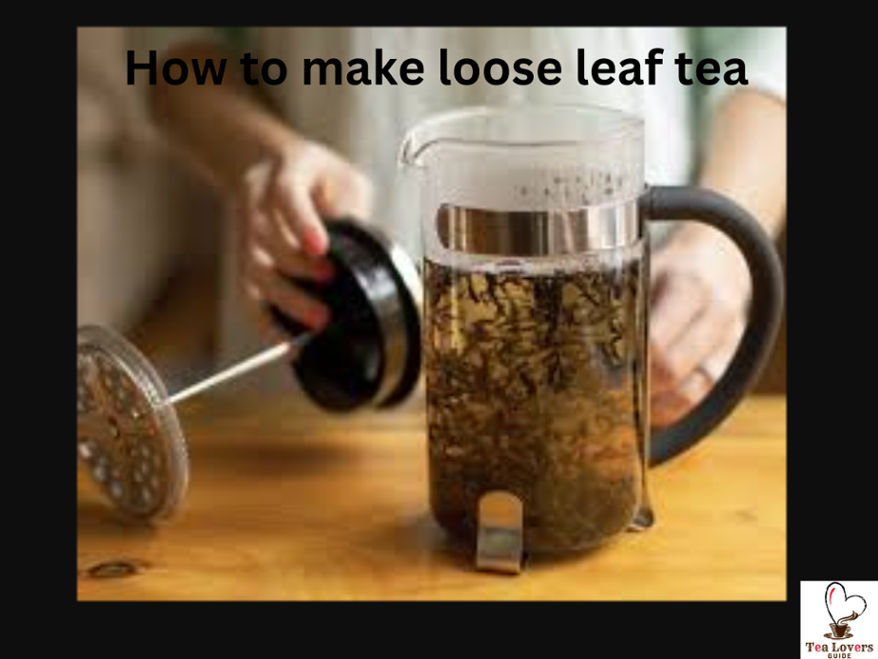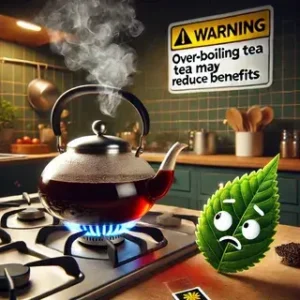Loose leaf tea offers a fresh, flavorful alternative to traditional bagged tea. Unlike tea bags, which often contain dust or fannings, loose leaf tea uses whole or large leaves, providing a richer flavor and better aroma. It’s also packed with more antioxidants, offering numerous health benefits.
This guide will teach you how to make loose leaf tea easily, helping you enjoy the perfect cup every time. Whether you’re a beginner or a tea lover, you’ll find everything you need to know about brewing loose tea.
Why Choose Loose Leaf Tea Over Tea Bags?
Quality Difference
Loose leaf tea is usually better in quality than bagged tea. Tea leaves in bags are mainly made of broken leaves or dust that lose most of the essential oils and flavors in the processing procedure. Loose leaf tea, however, uses whole leaves or large ones, which retain their natural properties, hence a more vibrant taste.
Flavor Profile
Because the leaves are larger, loose-leaf tea is brewed to a richer and more complex flavour. You can expect more aromatic and satisfying cup tastes than often bland tastes produced by bagged tea. The leaves expand fully within the water, releasing all of their natural flavors, giving you a depth-and-nuance-rich taste in your tea.
Health Benefits
Loose leaf tea has a more substantial amount of antioxidants and nutrients than bagged, since the bigger leaves maintain these compounds better. Drinking green tea for anti-inflammation or black for heart health, loose leaves will give you a more intensified amount of these good compounds in your body.
Types of Loose Leaf Tea
There are many different types of loose leaf tea, each with its special flavors and health benefits. Here is a quick guide to help you choose the best one for you:
Black Tea
Bold and robust, black tea is the most widely consumed tea globally. It contains a high amount of caffeine and gives a strong full-bodied flavor. To brew loose black tea, temperatures are higher (200-212°F) and steeping time is longer (3-5 minutes).
Green Tea
This is a very light, grassy flavored tea. It is said that it has many health benefits, such as a rise in metabolism and a healthy brain. This brews at best at lower temperatures: 160-185° F for 1-3 minutes to preserve its light flavor.
White Tea
White tea is light and sweet, comprising young tea buds and leaves. The least processed, white tea contains the most antioxidants. To steep loose white tea, the water temperature must be at 170–185°F, and it should steep for 2–4 minutes.
Herbal Tea
Herbal teas are caffeine-free and consist of a wide variety of herbs and spices. Some of the popular herbal types include chamomile, peppermint, and rooibos. Herbal teas are steeped in boiling water (200–212°F) for 5–7 minutes.
Oolong Tea
Oolong tea is partially oxidized and therefore has a balanced flavor profile between black and green teas. Its flavor may vary from floral to fruity. Brew it at 180–200°F for 3–5 minutes for the best results.
Pu-erh Tea
Pu-erh tea is fermented and aged, which makes it unique. It gives deep earthy flavor. For brewing loose pu-erh tea, you need to use near-boiling water, that is, 200–212°F and steep it for 3–5 minutes.
Essential Equipment for Making Loose Leaf Tea
To make the perfect cup of tea, you’ll need a few pieces of essential gadgetry. Here is the list of things you should get:
Teapot or Mug Infuser
A loose leaf tea requires a teapot or mug infuser. Ceramic, glass, or stainless steel are options. A teapot is great for serving several people, and a mug infuser is great for one person. Both allow the leaves to unfurl and expand freely while steeping.
Tea Infusers or Strainers
If one does not have a teapot with an infuser, a separate one or strainer must be acquired. Infusers can take the form of mesh balls, baskets, as well as reusable tea bags. They allow the leaves to remain within the container but let water flow through.
Kettle
One that allows control of temperatures is perfect for precise brewing. Depending on the type of teas you are brewing, different temperatures might be preferred for brewing certain types of teas. With an electric kettle, it is possible to set the right temperature for the type of tea you want to brew.
Optional Equipment
While not required, some equipment makes your brewing experience with tea much better:
- Tea Timer: So that the tea you have steeped is perfectly for that amount of time.
- Thermometer: Making sure the water attains the right temperature.
- Tea Scale: You will be able to measure the amount of tea leaves, so you can have the exact quantity for constant brewing.
Step-by-Step Guide on How to Make Loose Leaf Tea
Now that you have the right equipment, let’s go through the step-by-step process of making loose leaf tea:
Step 1: Measure the Tea
Use approximately 1 teaspoon of loose leaf tea for every 8 ounces of water. For stronger tea, add more leaves, but be cautious to avoid bitterness. Different types of tea may require slight adjustments in the amount of leaves used.
Step 2: Heat the Water
To brew the best cup of tea, heat your water to the right temperature. Here are the ideal temperatures for various types of tea:
- Green tea: 160–185°F
- Black tea: 200–212°F
- White tea: 170–185°F
- Oolong tea: 180–200°F
- Herbal tea: 200–212°F
A kettle with temperature control can make this step easier.
Step 3: Add the Tea Leaves
Place the tea leaves into your infuser or teapot. Ensure the leaves have enough space to expand as they steep. This will allow the flavors to fully infuse into the water.
Step 4: Steep the Tea
The steeping time will vary depending on the type of tea:
- Green tea: 1–3 minutes
- Black tea: 3–5 minutes
- White tea: 2–4 minutes
- Oolong tea: 3–5 minutes
- Herbal tea: 5–7 minutes
If you steep the tea for too long, it may become bitter. If it’s under-steeped, the flavor may be too weak.
Step 5: Remove Leaves and Serve
Once the tea has steeped, remove the leaves to prevent over-brewing. You can enjoy your tea as is or add sweeteners, milk, or lemon according to your preference.
Tips for Getting the Perfect Brew
Experiment with Ratios
Taste your way through this: stronger, use more leaves; milder, fewer.
Filtered Water
Filtered water makes an even bigger difference in tea flavor because it has fewer impurities than tap water. Great water helps the essence and flavor of the content shine through.
Stir or Swirl
Stirring or gently swirling your tea will help in the even extraction of flavors, especially for teas that have larger leaves.
Try Cold Brew
Cold brewing loose leaf tea means smoother, milder flavors. Steep leaves in cold water overnight in the fridge for a refreshing iced tea.
Loose Leaf Tea Recipes to Try
Try these easy and tasty recipes to lead you on your journey of loose leaf tea:
Classic Black Tea Recipe
Black tea is steeped at 200-212°F for 3-5 minutes. Whether taken with milk or sugar, the recipe is quintessential.
Refreshing Green Tea with Mint
Green tea is steeped at 160-185°F for 2-3 minutes, and as a twist, fresh leaves of mint make for refreshing green tea.
Herbal Chamomile Blend
Steep chamomile flowers for 5-7 minutes in water at 200°F. This caffeine-free drink is great for right before bed.
Iced Oolong Tea
Steep oolong tea at 185-205°F for 3-5 minutes. Chill and pour over ice to make a refreshing drink.
Spiced Tea
Use black tea with spices like cinnamon, cardamom, or cloves. Steep for 3-5 minutes in water at 200-212°F to create an aromatic, warming drink.
Health Benefits of Loose Leaf Tea
Antioxidants and Nutrients
Loose leaf tea is rich in antioxidants that may help increase immunity, heart health, and prevent cell damage. Loose leaf has more nutrients as compared to bagged.
Less Processed
Since loose leaf tea is much less processed, it still contains most of its natural compounds that are full of goodness. The slight processing ensures you experience all the health-giving powers of each individual leaf.
Hydration
Herbal teas are good for hydration since they are quite soothing and calorie-free beverages to stay hydrated through the day.
Relaxation and Mental Acuity
There is some L-theanine in those teas such as green tea. They relax, yet focus, while they also relieve anxiety. There are some fabulous teas, really.
Frequently Asked Questions About Brewing Loose Leaf Tea (FAQs)
How Long to Steep Loose Leaf Tea?
Steeping times vary, depending upon the type of tea. It can steep from 1-3 minutes for green tea, but with black tea, sometimes you would steep up to 3-5 minutes. Always follow the recommended times for the best flavor.
Can You Reuse Loose Tea Leaves?
Yes! You can steep tea leaves 2-3 times, at least with oolong and black tea. Do remember to decrease the steeping time a little each time.
Is Loose Leaf Tea Environmentally Friendly?
Absolutely! Loose leaf tea is generally more environmentally friendly than any tea bag, as the bags contain plastic and are sold individually. Loose leaf teas also minimize waste and typically come in bulk with minimum packaging.
How Do You Store Loose Leaf Tea?
Loose leaf tea has to be kept in an airtight container. You should store it away from direct sunlight, moisture, and strong smells, preferably in a cool, dark place. That way, its flavor and freshness will not get spoiled.
What Is the Best Loose Leaf Tea for Beginners?
For beginners, you can opt for mild, easy-to-find teas, such as jasmine, chamomile, or a light green tea.




